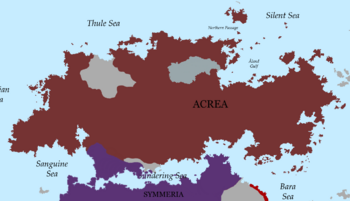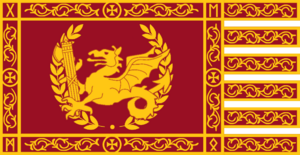Acrean Empire
Acrean Empire Norðreyjar Nordregnum | |
|---|---|
| 296 BCE–1016 CEa 1330 CEb | |
 The traditional territory of the Acrean Empire | |
| Capital | Rena |
| Common languages | Elder Nordic Elder Venetian |
| Religion | Valstígr |
| Demonym(s) | Acrean |
| Government | Absolute Monarchy |
| Keisari (Elder Nordic) Caesar (Elder Venetian) | |
| Historical era | Antiquity to Medieval |
• Established | 296 BCE |
• Dissolved | 1016 CEa 1330 CEb |
| Currency | Mark |
| Today part of | Avallon |
| |
The Acrean Empire, also called the Empire of Acre, was ancient empire in Eracura. Originally a confederation of allied city states and their territories called the Acrean League and grew to become an empire which dominated the continent for nearly a millennium. The Empire served as the home of the Nordic peoples, today one of the largest ethnic groups in the Tyran. The Acrean Empire is considered to have been at its relative zenith from 100 BCE to 500 CE.
Since early antiquity, the territory of modern day Acrea had long been dominated by a collection of powerful city states, primarily led by five: Rena, Ravenna, Arcanea, Trier, and Coria. Collectively these city-states were known as the Pentarchy, and controlled a majority of trade and extensive territory throughout Acrea. Tensions with the expanding Sabrian Empire led these city-states to form the Acrean League under the combined leadership of Rena and Ravenna, whose united polity was known as Acre in honour of the ancient metropolis from which the city of Rena grew. The Acrean League emerged victorious in the ensuing First Acrean-Sabrian War under the war leadership of Generals Valarys Aurelius of Ravenna and Vithmirax Aelarssen of Rena. Alongside the material and geopolitical benefits the League realised with its victory, the experience of uniting against the Sabrians and the common experience of the war transformed political and social dynamics amongst the various polities which made up the League. As a result, in 296 BCE, Aurelius called the Diaeta Regni in Ravenna to propose uniting all of the League into single rule, and supported Vithmirax as its head. History records some descent initially, but ultimately the three-week long assembly ended in agreement and Vithrimax was named Keisari of the new Acrean state.
The Acrean Empire gradually expanded over the next few centuries. It first conquered southeastern Eracura from the Sabrians during the Second Acrean-Sabrian War, often being aided by local rulers who allied with the Acreans over their former Sabrian governors, though nearly as many remained loyal to the Sabrians. The Nordic peoples of modern-day Nordkrusen and Delkora joined the Acreans by agreement after being offered automatic citizenship. Acrea's westward expansion was slow and deliberate, marked by extensive construction projects which accompanied armies west to establish roads and infrastructure.
Etymology
The name "Acrea" is derived from the ancient name for the city of Rena, called Acre. The origin of the city's ancient name is unclear, however it is referenced in writing as early as 1040 BCE. The use of the term "Acrean" to describe the confederation of city states is contemporary; it was deliberately chosen by leaders of the era to invoke the importance of the ancient metropolis in commerce and communication amongst all peoples of the territory that came to be known as Acrea.
The more common native official words used to describe Acrea, Norðreyjar and Nordregnum, originated after the establishment of the Acrean Empire. Norðreyjar is a shortened form of Norðurkeisarreyjar, literally translating to "Northern Realm of the Keisar" and meaning "Northern Empire". The full Nordic name was adapted directly by the Venetian-speaking peoples of southern Acrea as Caesarregnum Aquilonaris, though colloquial speech in these areas gradually nordicised and shortened to Nordregnum. The names referenced the "eastern" Sabrian Empire and the newly founded "southern" Symmerian Empire, the latter of which was known known to the Acreans through trade and the influx of Kydonians who settled in Venetia during the Kydonian Migration.
Use of those names over simply referring to Acrea as such became more common in official speech as a measure of public inclusiveness to aid in the integration of non-Acrean peoples as citizens of the Empire in its early period, and in colloquial speech so as to make a distinction between the Empire as a whole and Acrea proper.
History
Institutions and Government
The Acrean Empire was ruled by the Keisari, adapted as Caesar in Venetian and meaning "emperor". The Emperor was responsible for all aspects of government, serving as the head of state, head of government, chief justice, and supreme commander of Acrea's legions. As established at the Diaeta Regni of 296 BCE, the Acrean Emperor did not rule with absolute power but was kept in check by a representative legislature, the Ráði Regni or Royal Council.
The Royal Council was at first comprised of prominent elected citizens who served as representatives of their communities within Acrea, though later grew to include representatives of foreign provinces of the Empire who were appointed by provincial governors after being put forward as candidates by local communal leaders. The authority of the Council over the Emperor as dictated by Acrean law was understood to be granted by a combination of public will and divine right. In a number of cases this proved insufficient, as savvy Emperors often overcame the Council's role as a check of power by currying public popularity and using political maneuvering to stack the Council's seats in their favour.
Military
The ancient Acrean military was one of the most distinguished fighting forces of antiquity. The ancient Acreans fielded a mostly professional fighting force, first established by the reforms of Rena-born General Varax Sigericssen in 290 BCE. Composition of the ancient Acrean army reflected the political structure of the empire. The army created by Varax was comprised of two parts: legions and auxiliaries. Legions were formations recruited from Svæðiis Primis, provinces whose populations were granted the right to Acrean citizenship, and formed the core of the army throughout its history.
Acrea's geographical and cultural diversity allowed them to maintain a variety of troops as part of the legions. Varax's reforms were the first to establish the Triade composition for legions, which dictated that any particular legion should be comprised of a combination of Legionæres, Arcetæres, and Equitæres.
Legionæres, or legionaries, were the heavy infantry of ancient Acrea and the foundation of any legion. Legionaries' equipment varied based on where and by whom a unit was raised. Some of the most heavily armoured troops of the ancient world, Acrean legionary armour was typically either riveted chainmail, scale armour, or segmented plate armour from lightest to heaviest. Additional protection came from large oblong or rectangular shields commonly referred to as skiða or scuta. Fitted with large metal bosses and often with metal rims, they provided excellent protection as well as offensive versatility. The legionaries' primary weapon was a spaði or spatha straight sword, though shorter atrekr swords optimised for thrusting were also widely used by some troops. They additionally carried javelins and daggers.
Arcetæres was a term which originally referred to archers, but over time grew to also encompass troops which referred to missile troops equipped with a crossbow (arcuballista). Archers were considered critical to the tactical capability of a legion, and were also considered more valuable; whereas a legionary recruit could be trained in as little as five months, arcetæres were typically recruited and trained from a young age at an arcetærskóla where communal archery practice was held throughout the week. The availability of arcetæres reflected the importance of martial tradition in Acrean society as a whole, where activities such as archery were very common athletic pasttimes for youths regardless of wealth or social class. Thus, by the time a young man reached the typical military age of 17-18, he would have upwards of 12-13 years of experience in archery. Although this made arcetæres difficult to easily replace, it enabled them to utilise powerful bows with excellent accuracy and a high rate of fire. This was necessary, as typical Acrean war bows of antiquity had an average draw weight of 670-750 N (~150-170 lbs), with some surviving examples estimated to reach as high as 820 N (~185 lbs), with which a unit of arcetæres was expected to achieve a rate of up to ten volleys per minute. Using heavy war arrows, the arcetæres could have a devastating effect on opposing formations. The types of war bows used varied based on time and place in Acrean history. Early arcetæres used bows common to where their unit was recruited from. Those from the cool, moist climates of northern Acrea usually used yew longbows while southern Acreans south in the warm, sunny climate south of the Aarau-Voers mountains used both longbows and composite recurve bows. Eventually, the yew longbow became the de facto standard due to its ability withstand a diverse range of climates, very low cost, and extreme ease of manufacture relative to composite bows. In combat, the arcetæres were protected by a combination of friendly light cavalry and legionaries armed with hasta spears used to ward off enemy cavalry charges.
The equitæres were the cavalry of the ancient Acrean army. They were divided between heavy cavalry, called Riddari, and light cavalry, called Caballari. The Riddari were heavily armoured shock cavalry armed with both a long spear and spatha, used as a maneuver force to attack the flanks or rear of enemies pinned in place by legionaries. Riddari were heavily armoured and usually wore a full-body variation of the legionaries' segmented plate armour, and likewise used either full or partial horse armour. The caballari typically wore armour almost identical to legionaries, and were armed with the same weapons as riddari. They utilised oblong shields specifically designed for use on horseback, meant to provide some more protection for the cavalryman's legs while retaining mobility. Caballari were used to screen the legion and protect its flanks and rear.
